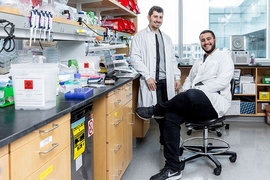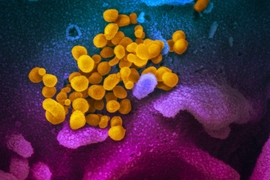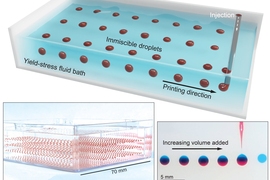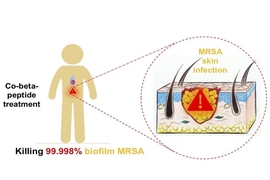Before the world was alerted to the threat of a novel coronavirus spreading out from China, Hadley Sikes was already well acquainted with developing molecular technology to improve diagnosis and treatment of diseases. Now working on a crucial diagnostic test to find people with Covid-19, the Esther and Harold E. Edgerton Associate Professor of chemical engineering at MIT and principal investigator of the Antimicrobial Resistance Interdisciplinary Research Group at Singapore-MIT Alliance for Research and Technology (SMART), and her collaborators have managed to condense months of work into a matter of a few weeks.
Q: Where does your work fit in with the global Covid-19 research effort?
A: The Covid-19 pandemic has presented a huge challenge for the world’s capacity for diagnostic testing. It has given us a clearer picture of what our actual capabilities are because all the countries in this effort are as motivated as they could ever be to deploy technologies that can test populations as quickly and accurately as possible.
Scientists have only been able to deploy one kind of test so far to identify people who have Covid-19. The coronavirus that causes this illness is made out of proteins and RNA, and so far, we only detect its RNA. RNA tests are complicated and can take hours, or even days, for doctors to receive the results. A faster version of an RNA test was just announced, but it also requires laboratory equipment and it is difficult to produce as many tests are needed.
What I’ve been working on at MIT and SMART, MIT’s research enterprise in Singapore, is developing protein tests that are quick to run and don’t require laboratories. These tests can find out if viral proteins are present in bodily fluids and also if a patient’s immune system has responded to the SARS-CoV-2 virus.
That is information that is critical, especially in this situation whereby countries are shutting down. If you know who has had the infection and recovered, and thus now has immunity, you have the potential to keep things running without putting more people at risk.
Before this outbreak, we had been working with support from the Deshpande Center on protein tests to diagnose malaria, dengue, and tuberculosis. Our goal was to find a way to capture more of the proteins made by these pathogens by developing binding reagents that concentrate the proteins within a testing device. We also wanted our tests to be affordable and easy to produce in large quantities.
Developing the reagents is a slow but crucial part of the process of developing a clinical protein diagnostic, and typically takes longer than for nucleic acid tests.
Dr. Eric Miller, who is in my lab at MIT, and Dr. Patthara Kongsuphol at SMART, have been working on engineering reagents that capture more of the scarce viral proteins in a patient’s bodily fluids. If more of these viral proteins can be captured, the test can be more sensitive.
With the Covid-19 pandemic as his motivation, Dr. Miller figured out how to engineer these binding agents in just two weeks — much sooner than the several months it might typically take. On the SMART side, Dr. Kongsuphol has been leading our efforts in Singapore to integrate these agents into diverse test formats that can be challenged with clinical samples.
We are aiming to create a test that can work in 10 minutes and doesn’t require specialized instruments or laboratory infrastructure. In this way, it can be carried out at an airport or a clinic to accurately show if a person either has or is immune to Covid-19. It’s challenging to make a test that is sensitive and accurate enough, and also a huge challenge to scale up production of such a test fast enough to have an impact when a new pathogen emerges.
Q: What influence has Singapore had on your work?
A: I have been at MIT for 10 years and started working with SMART two years ago. Joining an interdisciplinary research team in Singapore has given me a really great chance to work on a pressing medical problem of our time, which is antimicrobial resistance. It allows me to work with world-class clinicians and government agencies that are international leaders in public health, and with top researchers at Nanyang Technological University, the National University of Singapore, and the Agency for Science, Technology and Research.
I spent January in Singapore and went back again at the beginning of March, just as the outbreak was emerging in the United States. I really wanted to learn more about how Singapore’s experience during the SARS outbreak in the early 2000s allowed them to respond so effectively to this outbreak, particularly with diagnostic testing.
It was nerve-wracking being separated from my family at this time. I have three young children and a husband who has a full-time job. Because of the 12-hour time difference with Boston, we had a lot of late-night and early-morning FaceTime chats.
They have been really supportive of the work my team and I are trying to do. I think they are glad I went to Singapore because they see that I am doing what I can to play a role in figuring out effective responses to this, and future public health crises. The mission provides a powerful sense of purpose.
The United States is fortunate that it had not experienced the SARS or MERS outbreaks Singapore and other Asian countries had been through, but this means we are lacking in the knowledge and experience these countries have gained. The United States and other countries can learn a lot from Singapore.
After that event, Singaporean officials analyzed everything that happened and put in place new public health measures designed to effectively manage and contain any future outbreaks. By doing this, they have developed a world-class response.
Q: What did you learn in Singapore?
A: I valued getting to speak to the doctors on the ground who were fighting the Covid-19 outbreak in Singapore and learning what they had seen during their case management amid the crisis.
When I arrived in Singapore, I was honored to get to speak with Dr. Sidney Yee, CEO of the Diagnostics Development Hub, who had worked to rapidly produce a high-performing RNA test and ensure it was quickly deployed as part of Singapore’s effective response to Covid-19.
I was also able to talk to my colleague at SMART, Dr. Tsin Wen Yeo, while he was doing shifts in the Intensive Care Unit, caring for Covid-19 patients. He gave me his views about what was required from a diagnostic protein test. I think it was an incredible opportunity to understand the needs of doctors in different settings and it focused the efforts of my team. Understanding how diagnostic tests will be used allows us to prioritize the things that doctors find most important.
You could make all sorts of diagnostic tests, but the ones we focus our effort on are the ones that are going to provide doctors with actionable information that will help them treat their patients.
This is a really interesting time now that there is a sudden emphasis on needing better, faster diagnostics for the world’s health-care systems. Engineers have a big role in providing these, for the benefit of patients and health workers, and also to help economies get back on their feet. I hope that this desire for more practical diagnostic research continues after we recover from this outbreak.












